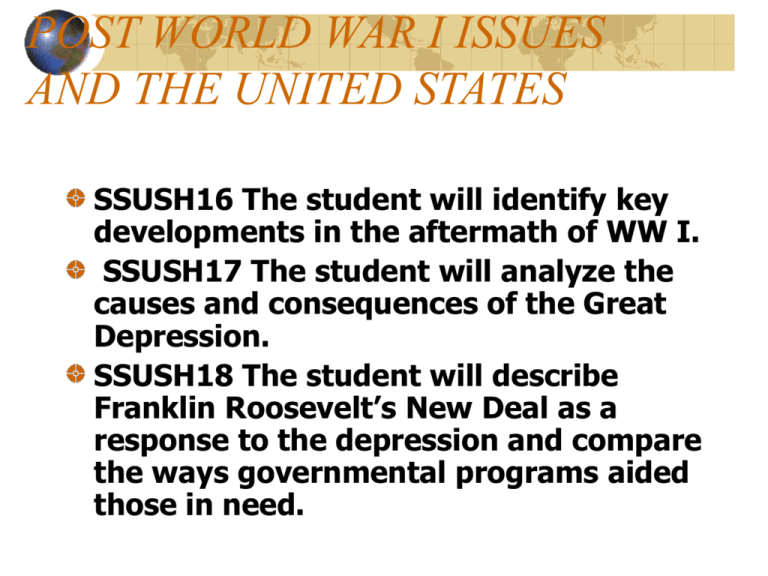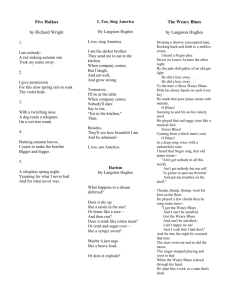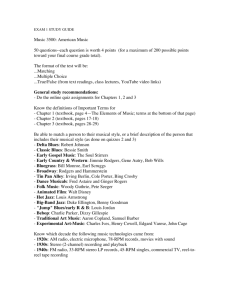post world war i issues and the united states
advertisement

POST WORLD WAR I ISSUES AND THE UNITED STATES SSUSH16 The student will identify key developments in the aftermath of WW I. SSUSH17 The student will analyze the causes and consequences of the Great Depression. SSUSH18 The student will describe Franklin Roosevelt’s New Deal as a response to the depression and compare the ways governmental programs aided those in need. POST WORLD WAR I ISSUES AND THE UNITED STATES 1. POSTWAR TRENDS A. NATIVISM-is opposition to immigration which originated in United States politics with roots in the country's historic role as a melting pot. Prejudice against foreign-born people B.ISOLATIONISM-a foreign policy which involves a non-interventionist military policy; Political rulers should avoid entangling alliances with other nations and avoid all wars not related to direct territorial self-defense. Avoiding involvement in world affairs POST WORLD WAR I ISSUES AND THE UNITED STATES: TRENDS, CONTINUED C. THE FIRST RED SCARE 1. A PERCEIVED THREAT, COMMUNISM… a.ECO/POL SYSTEM BASED ON ONE PARTY GOVT RULED BY DICTATORSHIP b.the First Red Scare took place in the period 1917–1920, and was marked by a widespread fear of anarchism POST WAR TRENDS The First Red Scare began during World War I in which the United States fought during 1917-1918. The Bolshevik revolution in Russia and the ensuing Russian Civil War (1917–1923) inspired a widespread campaign of violence in the U.S. by various anti-government groups. POST WAR TRENDS Political cartoon of the era depicting an anarchist attempting to destroy the Statue of Liberty. POST WAR TRENDS The largest government actions of the Red Scare were the Palmer Raids against anarchist, socialist, and communist groups. Left-wing activists, such as five-time Socialist presidential nominee Eugene V. Debs, were jailed by government officials using the Espionage Act of 1917 and the Sedition Act of 1918. A. Mitchell Palmer, U.S.Attorney General RED SCARE, PALMER RAIDS A. MITCHELL PALMER POST WAR TRENDS 1. REACTIONS TO RED SCARE…AND NATIVISM a.surge of patriotism, often involving violent hatred of communists, socialists, radicals, and immigrants b.immigrant quota system, the max number of immigrants which could enter USA SACCO AND VANZETTI CASE (EXAMPLE OF IMMIGRANT HYSTERIA) Ferdinando Nicola Sacco (April 22, 1891) and Bartolomeo Vanzetti (June 11, 1888) were two Italian-born laborers and anarchists who were tried, convicted and executed via electrocution on August 23, 1927 in Massachusetts for the 1920 armed robbery and murder of a pay-clerk and a security guard in Braintree, Massachusetts. SACCO AND VANZETTI SUMMATION, GPS 15, 16a. SSUSH15 The student will analyze the origins and impact of U.S. involvement in World War I. a. Describe the movement from U.S. neutrality to engagement in World War I, with reference to unrestricted submarine warfare. b. Explain the domestic impact of World War I, as reflected by the origins of the Great Migration, the Espionage Act, and socialist Eugene Debs. c. Explain Wilson’s Fourteen Points and the proposed League of Nations. SSUSH16 The student will identify key developments in the aftermath of WW I. a. Explain how rising communism and socialism in the United States led to the Red Scare and immigrant restriction. RISE OF SOCIALISM AND COMMUNISM The Communist Party of the United States of America (CPUSA) is a Marxist-Leninist political party in the United States. During the first half of the 20th century it was the largest and most widely influential communist party in the country, and played a prominent role in the U.S. labor movement from the 1920s through the 1940s, founding most of the country's major industrial unions and pursuing intense anti-racist activity in workplaces and city communities throughout this first part of its existence. Simultaneously the CPUSA survived the Palmer Raids, the first Red Scare, and many similar attempts at suppression of communist activity by the Government of the United States through the end of World War II. By August 1919, only months after its founding, the CPUSA had 60,000 members, including anarchists and other leftists, while the more moderate Socialist Party of America had only 40,000. POST WAR, AMERICAN BUSINESS 1.HENRY FORD - (July 30, 1863 – April 7, 1947) was the American founder of the Ford Motor Company and father of modern assembly lines used in mass production. His introduction of the Model T automobile revolutionized transportation and American industry. He was a prolific inventor and was awarded 161 U.S. patents. POST WAR, AMERICAN BUSINESS "Fordism“, the mass production of large numbers of inexpensive automobiles using the assembly line, coupled with high wages for his workers. HENRY FORD POST WAR, AMERICAN BUSINESS Mass production is the production of large amounts of standardized products on production lines. It was popularized by Henry Ford in the early 20th century, notably in his Ford Model T. Mass production typically uses moving tracks or conveyor belts to move partially complete products to workers to perform simple repetitive tasks. This permits very high rates of production. POST WAR, AMERICAN BUSINESS An assembly line is a manufacturing process in which parts (usually interchangeable parts) are added to a product in a sequential manner . The best known form of the assembly line, the moving assembly line, was realized into practice by Ford Motor Company between 1908 and 1915, and made famous in the following decade by the social ramifications of mass production, such as the affordability of POST WAR, AMERICAN BUSINESS, THE AUTOMOBILE P. 629, TEXT, IMPACT…READ AND LIST 3 IMPACTS OF THE CAR, THE AUTO. THE AUTOMOBILE, 1910, FORD MODEL T THE MODEL T, FORD first affordable automobile, the car that "put America on wheels" THE AUTOMOBILE “I will build a car for the great multitude. It will be large enough for the family, but small enough for the individual to run and care for. It will be constructed of the best materials, by the best men to be hired, after the simplest designs that modern engineering can devise. But it will be low in price that no man making a good salary will be unable to own one-and enjoy with his family the blessing of hours of pleasure in God's great open spaces.” HENRY FORD IMPACT OF AUTOMOBILE PAVED ROADS Route 66, "Main Street of America" or the "Mother Road" CULTURAL EXPRESSIONS, 1920S JAZZ, an American musical art form which originated in the beginning of the 20th century in black-American communities in the Southern United States from a confluence of African and European music traditions. JAZZ LOUIS ARMSTRONG, American jazz trumpeter and singer. IRVING BERLIN Irving Berlin (11 May 1888 – 22 September 1989) was a Russian-born American composer and lyricist, and one of the most prolific American songwriters in history. Berlin was one of the few Tin Pan Alley/Broadway songwriters who wrote both lyrics and music for his songs. "God Bless America", "White Christmas", "Anything You Can Do", "There's No Business Like Show Business" TIN PAN ALLEY Tin Pan Alley is the name given to the collection of New York City-centered music publishers and songwriters who dominated the popular music of the United States in the late 19th century and early 20th century. Tin Pan Alley was originally a specific place in New York City, West 28th Street between Fifth and Sixth Avenue. Derogatory reference to the sound made by many pianos all playing different tunes in this small urban area “Banging tin pans HARLEM RENAISSANCE The Harlem Renaissance Centered in the Harlem neighborhood of New York City Impacted urban centers throughout the United States across the cultural spectrum (literature, drama, music, visual art, dance) and also in the realm of social thought (sociology, historiography, philosophy) artists and intellectuals found new ways to explore the historical experiences of black America and the contemporary experiences of black life in the urban North. Challenged white paternalism and racism African-American artists and intellectuals rejected imitating the styles of Europeans and white Americans and instead celebrated black dignity and creativity. LANGSTON HUGHES, FAMOUS POET OF THE MOVEMENT HARLEM RENAISSANCE, LANGSTON HUGHES poet, columnist, dramatist, essayist, lyricist, novelist, social activist, writer (1923) 1 Droning a drowsy syncopated tune, 2 Rocking back and forth to a mellow croon, 3 I heard a Negro play. 4 Down on Lenox Avenue the other night 5 By the pale dull pallor of an old gas light 6 He did a lazy sway .... 7 He did a lazy sway .... 8 To the tune o' those Weary Blues. 9 With his ebony hands on each ivory key 10 He made that poor piano moan with melody. 11 O Blues! 12 Swaying to and fro on his rickety stool 13 He played that sad raggy tune like a musical fool. 14 Sweet Blues! 15 Coming from a black man's soul. 16 O Blues! 17 In a deep song voice with a melancholy tone 18 I heard that Negro sing, that old piano moan-19 "Ain't got nobody in all this world, 20 Ain't got nobody but ma self. 21 22 23 24 25 26 27 28 29 30 31 32 33 34 35 I's gwine to quit ma frownin' And put ma troubles on the shelf." Thump, thump, thump, went his foot on the floor. He played a few chords then he sang some more-"I got the Weary Blues And I can't be satisfied. Got the Weary Blues And can't be satisfied-I ain't happy no mo' And I wish that I had died." And far into the night he crooned that tune. The stars went out and so did the moon. The singer stopped playing and went to bed While the Weary Blues echoed through his head. He slept like a rock or a man that's dead. Summary: The speaker of Langston Hughes's "The Weary Blues" describes an evening of listening to a blues musician in Harlem. With its diction, its repetition of lines and its inclusion of blues lyrics, the poem evokes the mournful tone and tempo of blues music and gives readers an appreciation of the state of mind of the blues musician in the poem. THE ROARING TWENTIES Roaring Twenties is a phrase used to describe the 1920s, principally in North America, that emphasizes the period's social, artistic, and cultural dynamism. 'Normalcy' returned to politics in the wake of World War I, jazz music blossomed, the flapper redefined modern womanhood THE ROARING TWENTIES… THE JAZZ AGE F. SCOTT FITZGERALD, THE GREAT GATSBY THE HARLEM RENAISSANCE CHARLES LINDBERGH, SPIRIT OF ST. LOUIS BABE RUTH, MLB PROHIBITION, BOOTLEGGERS, SPEAKEASIES FLAPPERS, in the 1920s referred to a "new breed" of young women who wore short skirts, bobbed their hair, listened to the new Jazz music




